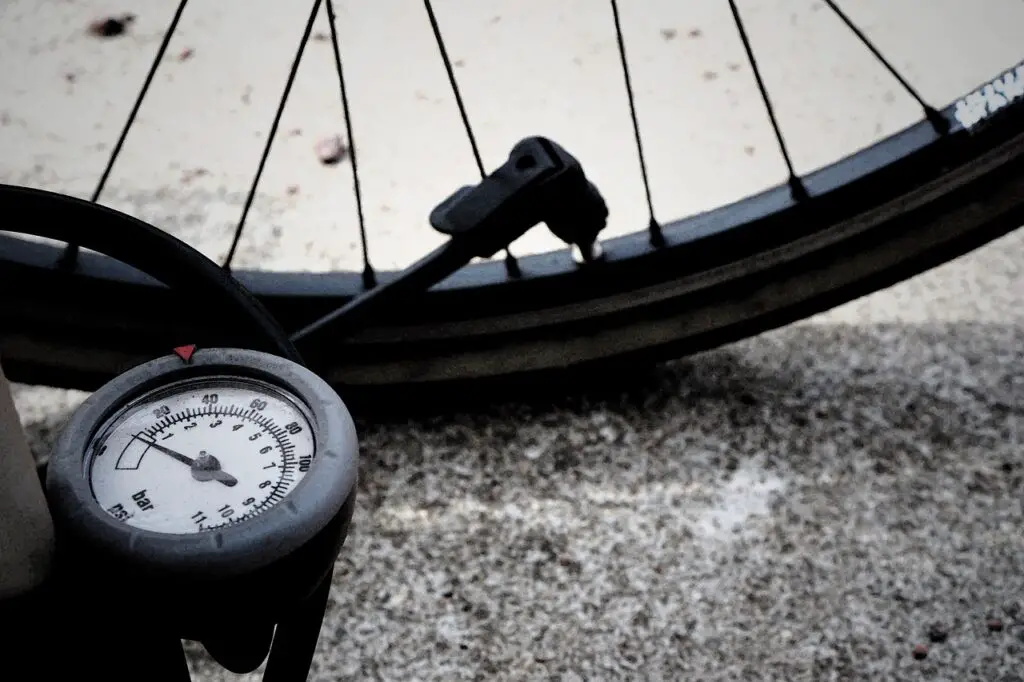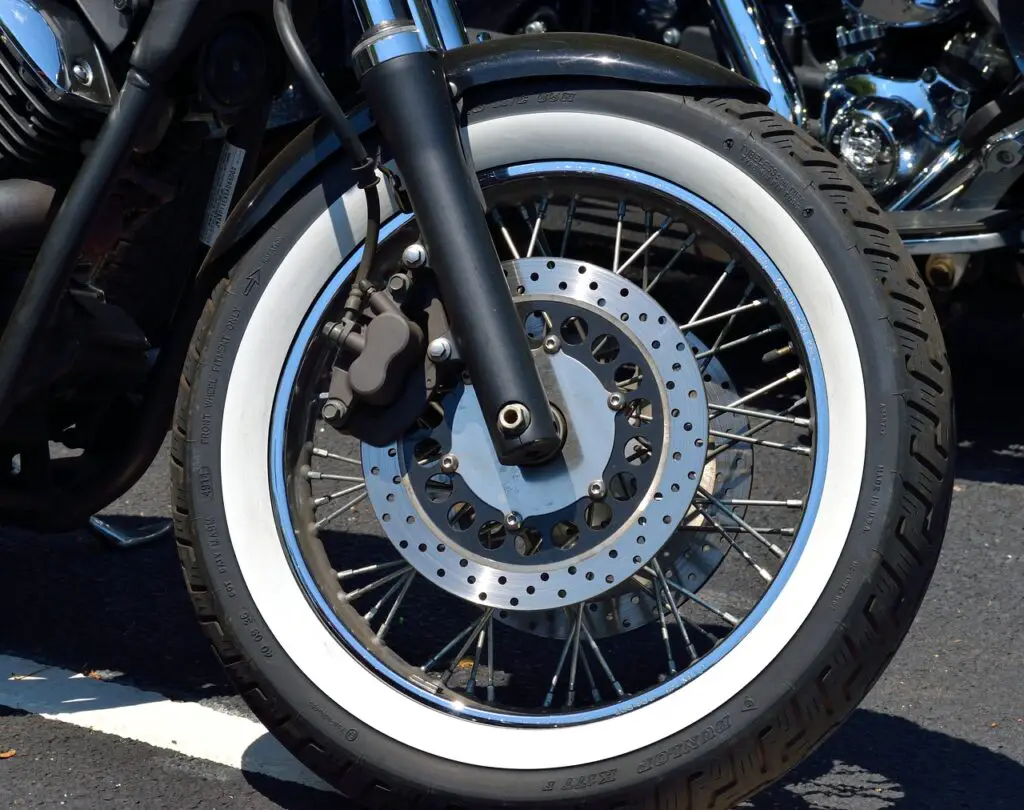We’ve all been there: stuck on the side of the road with a low tire and no way to fill it. Whether you’re to blame for ending up in this situation or not, you need a quick way to put some air in your tire so you can make it home. Many riders carry a small bicycle hand pump with them in case of situations like this. Is that a good idea? Let’s find out.
You can use a bicycle pump to put air in a motorcycle tire, as long as you are using an accurate gauge and only need to adjust by 1 or 2 psi. A hand pump will be more work for you, but it’s quiet, quick, and very handy in a pinch.
There are some situations where a bicycle pump shines and some situations when you really want to rely on a compressor. Find out when and how to check your tire pressure and pump your tires to keep your motorcycle in top condition.

Does a bicycle pump work on a motorcycle tire?
In short, the answer to this question is “yes.” Many motorcycle riders carry small bicycle pumps with them. These hand pumps are small and can fit under the seat, and they’re durable and easy to use in any situation.
Bicycle pumps are able to fill a motorcycle tire. However, it’s worth noting that bicycle pumps are designed for lower volume tires. This means that putting a significant amount of air into a motorcycle tire can be… tiring.
For example, you wouldn’t want to fill a tire from flat with a hand pump. Then again, if your tire is completely flat, there’s a good chance you need more than a pump.
Bicycle pumps are a great option for pressure maintenance. However, I strongly recommend you use a separate gauge that you know works well. Bicycle pumps, like gas station pumps, are notoriously inaccurate. You can use the bicycle pump, but don’t trust the gauge.
One other reason motorcycle riders opt for bicycle pumps is that they are easy and quiet. Many compressors make a lot of sound. If you’re trying to top off your tire pressure early in the morning before work, you might not want to wake up the entire household. In this case, a hand pump is the perfect option.
I want to mention, as well, that there are now several small compressors on the market that are designed for motorcycles. Some have plastic shells that can be removed to make them even smaller and more portable. All that to say that, while bicycle pumps are safe to use on motorcycle tires, there are other options out there.
How do you check the air pressure on a motorcycle tire?
Speaking of tire pumps, how do you know when your motorcycle tire needs air? Even the difference of one or two psi can impact the way your bike rides, as well as the safety of your ride. It’s essential that you know how to check the pressure on your tires before there’s a problem.
The first step in checking pressure is to invest in a good gauge. It’s recommended to purchase a few gauges. Occasionally you can compare them and make sure they are showing the same numbers and therefore reading correctly.
The amount of tire pressure you need will vary depending on your tires, your bike, and the temperature where you ride. It’s best to check your manual for this information, or contact a mechanic if you can’t find the information you need. You may also be able to find these details on the sticker on your bike’s swing arm.
Now, locate the valve stem and remove the cap. Attach the gauge, making sure you don’t hear any escaping air. If you aren’t sure how accurate your gauge is, compare it to another and make sure they match.
One tip for checking your air pressure is to check when your tires are cold, whether that’s in the morning before you ride or in the evening a few hours after your bike has been sitting. Heat will affect the pressure of the tires, so checking right after riding will taint your results.
How do you pump a motorcycle tire?
Once you’ve started the process of checking your air pressure, it’s not hard to refill if necessary. After completing the steps above, you’ll want to attach your bicycle pump or compressor.
Add air little by little, checking the pressure again before adding any more. Some people prefer to slightly overfill, since it’s easy to then release the air until reaching the correct psi. However, it isn’t a good idea to just add a ton of air at once, since it can be bad for the tire to be significantly overfilled.
As I mentioned above, you’ll want to check in your manual or with a mechanic to determine the psi your bike needs. Generally, motorcycle tires need between 28 and 40 psi. Of course, this is a big range, and even one psi can make a difference.
Therefore, it’s highly recommended that you find the correct psi for your bike and tires instead of trying to guess or go with the average. In the next section I’ll talk a little bit more about the dangers of under or overinflating your motorcycle tires.

How often should you check motorcycle tire pressure?
It’s good practice to check your motorcycle tire pressure before every ride. If you ride daily, you can probably reduce that to just twice a week, but it should be a regular part of your motorcycle maintenance no matter what.
Motorcycle tires that are underinflated can cause uneven wear to the tires and rims. They can also cause overheating and shorten the lifespan of your tires and bike.
On the other hand, tires that are overinflated will have worse traction and can also cause significant damage to both tire and rim.
In order to increase the lifespan of your tires and increase your own safety while riding, checking tire pressure is a must. You should know the correct psi for your bike tires and should check often.
When you do check your motorcycle tire pressure, it’s important to check when the tires are cold. Motorcycle tire pressure changes with temperature. Even riding half a mile to a gas station to check the air can negatively affect the reading.
It’s good practice to check the pressure in the morning before you ride or in the evening, several hours after your last ride. This will give you the most accurate reading and keep you from accidentally overinflating your tires.
Why do motorcycle tires lose pressure?
You may be wondering why you need to check your motorcycle tire pressure so often. After all, unless you ride over a nail or razor, why would the tire pressure change from one day to the next?
Tire pressure changes with time and use. One of the main reasons for pressure loss is permeation, when air particles seep out through the rubber of the tires. This isn’t a quick or noticeable process, but it does happen. Your tires are always losing a little bit of air. It’s roughly estimated that the tires will lose one psi every month.
Another thing that affects pressure is temperature. For every ten degrees of temperature change, you lose approximately one psi. This means that if the temperature drops from 60 to 40 degrees overnight, you’ll have lost about two psi.
Temperature and time are the two main culprits for tire pressure loss, but they aren’t the only things that can contribute to air loss. Many other problems can factor in for quicker pressure loss.
One obvious cause of lost air is a puncture. Whether there is a nail embedded in the rubber tire or a hole caused by a nail, sharp rock, razor, or other sharp object, a puncture will quickly result in a low or flat tire which will likely need to be replaced.
Tires can also crack from old age and extreme weather. When you’re doing your regular tire pressure checks, you should also be inspecting the tires for signs of wear and tear. Trust me, you’ll want to replace your tires before they go flat. Make sure you use tire pairs, motorcycle tires are not interchangeable.
Finally, tire pressure loss could be caused by a faulty valve, a bent rim, or a missing valve stem cap. If you are in the habit of regularly checking your tire pressure, you’ll be able to catch any of these problems more quickly and solve them before they get any worse.
